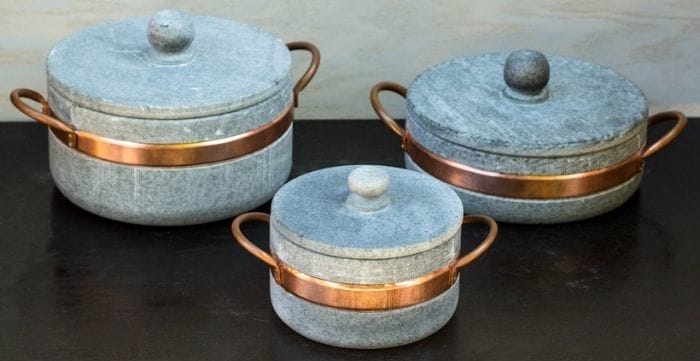
Soapstone cookware has been used in kitchens worldwide for thousands of years, dating back to the stone age. It was one of the tools that helped ancient humans enter the bronze age and progressive civilization. It’s a very versatile stone named after its soapy slippery touch and is used as cookware, especially for some wonderful properties it possesses. There are many pros of having Soapstone in the kitchen; let’s look at them:
Benefits of Soapstone Cookware
Soapstone is a soft metamorphic rock, also known as Steatite, composed of primarily talc and varying amounts of chlorites, mica, and other minerals. They are popularly known as Kalchatti in Tamil Nadu and South of India and is known to all for their incredible heat properties.
Insulation
Did you know that soapstone is used in chemistry labs because of its excellent ability to withstand high temperatures? Ancient humans learned this fact way before modern science understood it, which is why it’s found in kitchens for various cooking purposes.
Uniform Distribution of Heat
Unlike metal utensils that are commonly used because they are good conductors of heat, soapstone absorbs heat efficiently and gets heated uniformly, consequently, it distributes heat evenly, the biggest advantage of which is that food doesn’t burn or stick to the bottom of the vessel where it’s most likely to because of the proximity to the flame. This is a common issue with metal utensils, but not with soapstone!
Heat Retention and Fuel Efficiency
Soapstone absorbs heat slowly compared to metal containers that heat up really quickly, but the big plus is that it retains heat for a longer duration and is safe for cooking. This property ensures a good cooking process and reduces the cooking time and fuel used considerably. Due to its heat-retaining quality, it continues the cooking process even after turning off the flame. This also keeps the food warm for longer, so there is no need to reheat, thereby saving some more fuel and money for you in the long run.
Healthy Cooking
According to Ayurveda, food should be neither overcooked nor reheated again and again and consumed warm. Soapstone cookware takes care of all three principles to give us the benefit of health.
Excessive heating, overcooking, and reheating kill nutrients present in food. However, thanks to its slow heating and longer heat retention properties, soapstone helps preserve nutrients and keeps them intact.
Food cooked in soapstone is always nutritious and healthy. When there were no refrigerators, soapstone pots were the go-to choice to keep food fresh and preserved for long. It’s because it Cools down slowly and slows down the fermentation process to increase the shelf life of food. It also does not let bacteria grow in it. Soapstone is incredibly safe and healthy, especially for those with sensitive stomachs. Soapstone is also rich in minerals such as magnesium; this ensures food cooked is rich in many minerals essential to our overall well-being.
Long Shelf Life
Soapstone may be made up of soft metamorphic rock, but cookware made from it is hard, sturdy, and durable and can last for years if used well. Soapstone cookware generally has a long shelf life in kitchens and is often passed down generations. You must know if you’ve inherited some from your parents or grandparents.
Other than heat resistance, It’s also dirt and stain-resistant. Another of soapstone’s properties is acid, alkali, chemical, and alcohol resistance, and non-reactive. Cooking acidic or alkaline foods helps neutralize and dilute their acidic or alkaline content making the food healthy for consumption. Traditionally, stews, gravy, and chutneys that typically contain a lot of spices, herbs, and powerful ingredients such as tamarind were cooked in soapstone pots. It reduced the chance of acid reflux and stomach burn while also enhancing the taste.
Soapstone Cookware is an excellent choice for your kitchen; you can make your modern kitchen truly complete with soapstone cookware that serves the purpose no other does. Zishta brings you a fine collection of cookware and utility items in soapstone that you can invest in, handcrafted by rural artisans to support their livelihood and preserve the cultural traditions of our land. The cookware is pre-treated, seasoned, and tempered so that you can use it without any hassles.